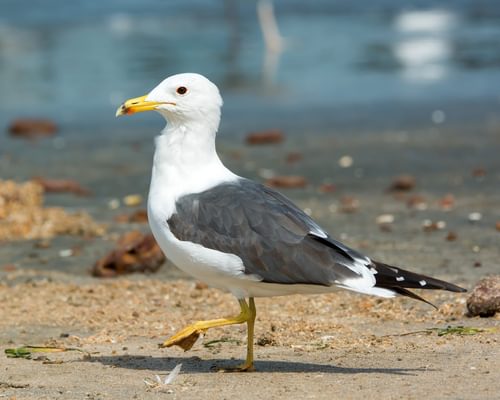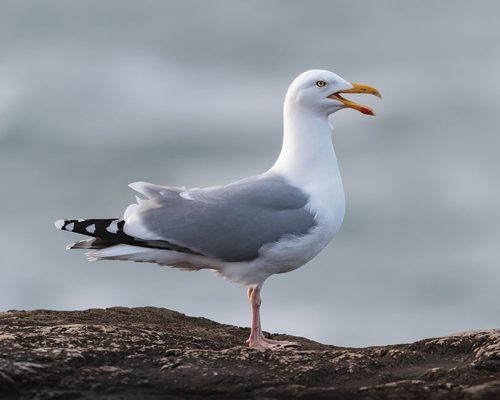Audouin's Gull
VulnerableIchthyaetus audouinii
Visual Identification
Appearance
The Audouin's Gull is a striking seabird. Its pristine white head and underparts contrast beautifully with its pale grey back and wings. Its most distinctive feature is the long, coral-red bill, often tipped with black and yellow. The dark eyes are surrounded by a red orbital ring.
Adults display a similar appearance year-round, with slightly duller colours in winter. Juveniles have brown mottling on their backs and wings, gradually acquiring adult plumage over three years.
Size
Length
48cm to 52cm
Wingspan
117cm to 128cm
Weight
550g to 770g
Colours
Males and females have similar plumage
Primary Colour
White Grey
Secondary Colour
Black
Beak Colour
Red
Leg Colour
Grey
Habitat and Distribution
Habitats
Woodland
Garden
Wetland
Coastal
Urban
Farmland
Grassland
Desert
Tundra
Rainforest
Mountain
Savanna
Distribution
Audouin's Gulls are predominantly found along the Mediterranean Sea coastlines, with the largest populations in Spain, Greece, and Turkey. They prefer sandy or rocky coastal areas, small islands, and occasionally inland wetlands.
During the non-breeding season, some individuals migrate to the Atlantic coasts of Morocco and Senegal. A small number may occasionally be spotted along the southern coasts of the UK, particularly during post-breeding dispersal.
Elevation Range
Sea level to 100 meters
Climate zones
Mediterranean, Subtropical
Distribution Map
This map gives you a rough idea of where you might spot a Audouin's Gull. The coloured areas show countries where these birds have been seen.
A few things to keep in mind:
- Birds might not be everywhere in the coloured areas, for example, they may be present around the coast of that country
- Where birds live can change with seasons and available food
- This map is quite simple - it doesn't show exact locations
We're working on making our maps even better! Soon, we hope to show you:
- More detailed maps for bigger countries, including state and region
- How birds move around during different seasons
Distribution by Region
Behaviour and Ecology
Bird Attributes
This feature is in beta. We'd love your feedback to improve it!
Share your thoughtsBird Attributes Explained
Our bird attributes system rates various aspects of a bird's capabilities on a scale of 0-100, based on data from field observations, scientific studies, and expert knowledge.
Attribute Categories:
- Agility: Manoeuvrability, speed, and grace in flight or movement.
- Strength: Physical power, often correlating with size and hunting abilities.
- Adaptability: Ability to thrive in various environments or changing conditions.
- Aggressiveness: Territorial behaviour and assertiveness, particularly during breeding seasons.
- Endurance: Stamina, often seen in migration patterns or foraging behaviours.
Understanding the Ratings:
- 0-20: Very Low
- 21-40: Low
- 41-60: Average
- 61-80: High
- 81-100: Very High
Remember, these attributes are relative to other bird species and don't necessarily indicate superiority.
Hover over the icon next to each attribute for more information.
Tap the icon next to each attribute for more information.
Agility
Reflects the bird's manoeuvrability, speed, and grace in flight or movement.
The Audouin's Gull demonstrates high agility through its graceful, low flight over coastal waters and its ability to catch small pelagic fish. Its specialised fishing techniques, including night-time foraging, suggest excellent manoeuvrability.
Strength
Indicates the bird's physical power, often correlating with size and hunting abilities.
As a medium-sized gull, the Audouin's Gull possesses moderate strength. Its ability to carry fish prey and engage in long-distance flights indicates a reasonable level of muscular power, though it's not known for exceptional feats of strength.
Adaptability
Represents the bird's ability to thrive in various environments or changing conditions.
The Audouin's Gull shows good adaptability, having recovered from near extinction and adjusting to various coastal habitats. Its specialised diet and ability to drink seawater demonstrate adaptation to marine environments, though it's less versatile in feeding habits compared to some gull species.
Aggressiveness
Measures the bird's territorial behaviour and assertiveness, particularly during breeding seasons.
Described as less aggressive than other gulls, the Audouin's Gull tends to be quieter and more specialised in its feeding habits. It doesn't typically engage in the boisterous behaviour often associated with gulls, preferring to focus on its fish-catching expertise.
Endurance
Reflects the bird's stamina, often seen in migration patterns or foraging behaviours.
The Audouin's Gull displays good endurance, evidenced by its partial migratory behaviour and ability to forage over wide areas of coastal waters. Its capacity for long-distance flights to wintering grounds in West Africa suggests a robust level of stamina.
Diet
Audouin's Gulls are primarily piscivorous, specialising in catching small pelagic fish like herrings, sardines and anchovies. They often feed at night, taking advantage of fish attracted to the surface by artificial lights.
Unlike many gull species, they rarely scavenge human refuse. They will also forage on land and have been observed taking small mammals and lizards as well as raiding olive groves.
Behaviour
Audouin's Gulls are graceful flyers, often seen gliding low over coastal waters in search of prey. Compared to other gulls, they are less aggressive and more specialised in their feeding habits.
These birds are generally quiet and prefer roosting in remote, flat areas near the shore.
Vocalisation
The Audouin's Gull has a distinctive call, a nasal 'aow-aow' or 'aahrr'. During the breeding season, they produce a variety of vocalisations, including a soft purring sound used in courtship. Their alarm call is a sharp, repeated 'kek-kek-kek'.
Nesting & Breeding
Audouin's Gulls typically form breeding colonies on small, flat coastal islands from April to July. Courtship involves elaborate displays, including head-tossing and mew-calling between partners.
Nests are simple scrapes on the ground, often sparsely lined with vegetation. Females lay 2-3 eggs, which are olive-brown with dark splotches, perfectly camouflaged against the surrounding terrain.
Both parents incubate the eggs for about 27-33 days. Chicks fledge after 35-40 days but remain dependent on their parents for several more weeks, learning crucial foraging skills.
Lifespan
The Audouin's Gull typically lives for 15 to 20 years, with a maximum recorded lifespan of 25 years.
Like all birds, lifespan can be affected by factors including predation, habitat quality, disease, and access to food sources.
Conservation and Status
Global Conservation Status
Once critically endangered, Audouin's Gull has seen a remarkable recovery thanks to conservation efforts but is still listed as Vulnerable.
Protection of breeding sites, particularly in Spain's Ebro Delta, has been crucial. However, the species still faces threats from habitat loss, overfishing, and climate change.
Birdwatching Tips
- Look for Audouin's Gulls along Mediterranean coastlines, especially near fishing ports.
- Observe their distinctive coral-red bill to differentiate from other gull species.
- Watch for their elegant, low flight over water during fishing activities.
- Visit breeding colonies on small islands during the spring and summer months.
Additional Information
Quick Facts
Other names:
Mediterranean Gull
Family:
LaridaePredators
Did You Know?
- Audouin's Gulls have specialised salt glands that allow them to drink seawater.
- They are named in honour of the French naturalist and ornithologist Jean Victor Audouin (1797 – 1841).
- Unlike many gulls, they rarely follow fishing boats for discards, preferring to catch live prey.
Was this bird profile helpful?
Your feedback helps us improve our content
Thanks for your feedback!
Your input helps us improve our content.
Community Experience
Community Ratings
No ratings yet - be the first to rate this bird!
Latest Community Reviews
No reviews yet
Sign in to be the first to review
Community Reviews
Create Your Free Account Welcome Back!
Join our community to rate birds and share your experiences. Creating an account is completely free and only takes a minute. Sign in to your account to rate birds and share your experiences with our community.
Your information is secure and will never be shared.
By creating an account, you agree to our Privacy Policy.
Similar Birds
References
- 2 3 4
website: BirdLife International. 2020. Larus audouinii. The IUCN Red List of Threatened Species 2020: e.T22694313A183584708.
View source - 1
website, 2010: Fransson et al., EURING list of longevity records for European birds
View source

